F. W. Pomeroy
Frederick William Pomeroy RA (9 October 1856 – 26 May 1924) was a prolific British sculptor of architectural and monumental works.[1] He became a leading sculptor in the New Sculpture movement, a group distinguished by a stylistic turn towards naturalism and for their works of architectural sculpture. Pomeroy had several significant public works in London and elsewhere in the United Kingdom, notably in Belfast. His work in London includes the figure of Lady Justice (1905–1906) on the dome of the Old Bailey.
Frederick William Pomeroy | |
|---|---|
| Born | 9 October 1856 Lambeth, London |
| Died | 26 May 1924 (aged 67) Cliftonville, Kent |
| Nationality | British |
| Alma mater | |
| Known for | Sculpture |
| Movement | New Sculpture |
Biography
Pomeroy was born in London, the son of an artist-craftsman.[2] After his father died in 1869 Pomeroy, aged 14, was left as the main wage-earner for the family and was apprenticed to a firm of architectural stone carvers.[1][3] Later he trained, for four years, with William Silver Frith at the South London Technical School of Art where he was also taught by Jules Dalou.[3] The naturalistic style of Dalou's sculptures were a great influence on Pomeroy's subsequent works.[3] In 1880, Pomeroy was able to enrol in the Royal Academy Schools, where he won a number of prizes, including silver medals in both 1882 and 1883.[4] In 1885 he won a gold medal and travelling scholarship which allowed him to study in Paris under Antonin Mercié and also in Italy.[3][4]
On returning to London, Pomeroy joined the Art Workers Guild in 1887, and in 1888 began exhibiting with the Arts and Crafts Exhibition Society.[5] In 1887 he was part of a group of artists, supported by the Royal Doulton Company, who created sculptures for a fountain in honour of Queen Victoria in Glasgow.[5] For the fountain, now situated on Glasgow Green, Pomeroy carved the group representing Australia.[5] Also in 1887 he met the architect J. D. Sedding who subsequently commissioned a large number of decorative architectural works from Pomeroy.[5] These included carvings for the Church of Our Most Holy Redeemer in London, an exterior sculpture for the tower of St Clement's Church in Bournemouth plus a screen and choir stalls in bronze for Holy Trinity, Sloane Street.[5][6]
Alongside his architectural work, Pomeroy continued to create smaller exhibition pieces. He carved a marble replica of Frederic Leighton's 1877 bronze sculpture Athlete wrestling with a python which was exhibited at the Royal Academy in 1891 before being transported to Denmark and, eventually, to Australia.[7] The piece was poorly received at the Academy in comparison to the bronze original but a number of other works in the New Sculpture style by Pomeroy helped build his artistic reputation.[7] These included his 1890 statuette of Dionysus, now in the Tate, So on a Delphic Reed from 1888 and Love the Conqueror shown at both the Royal Academy and the Walker Art Gallery in Liverpool during 1893.[8][5] During the 1890s, Pomeroy showed eleven works at the Royal Academy, eight of which were small statuettes.[5] Some of these, including Perseus and Love the Conqueror were reproduced in sizes suitable for the domestic market, although some much larger versions of Perseus were also cast.[5][9]
After Sedding died in 1891, his pupil Henry Wilson took over his architectural practice and continued to commission designs from Pomeroy.[5] These included a chimney piece, now destroyed, for a library at Ladbroke Grove in London, decorative items for the library and chapel at Welbeck Abbey in Nottinghamshire and a frieze for the chapel at Douglas Castle in South Lanarkshire.[5] The architect Edward William Mountford commissioned architectural sculptures and decorations from Pomeroy for Paisley Town Hall in 1890 and, more extensively, for Sheffield Town Hall in 1895.[5] For the latter Pomeroy created a number of works including a frieze of industrial workers, low-reliefs of figures representing Steam and Electricity, figures of Thor and Vulcan supporting the city crest plus a series of six lunettes and spandrels representing aspects of civic virtue.[5][10][11]
.jpg.webp)
In the first decade of the 20th-century, Pomeroy received several further commissions for architectural sculptures on buildings designed by Mountford. These included the figure of Lady Justice on the dome of the Old Bailey plus figures for the entrance to the court, statuettes, lamp standards and other decorations for the Liverpool Museum and Technical College, work for Lancaster Town Hall and a series of low-relief panels on gin-making for the exterior of Booth's Distillery in central London.[5][12] Starting in 1905 Pomeroy created four colossal bronze figures for the upstream side of Vauxhall Bridge in London.[5][13]
In 1907 Pomeroy became master of the Art Workers Guild. He was elected an Associate member of the Royal Academy in 1906, and a full member in 1917.[4] From 1898 to 1908 he was a regular exhibitor with the International Society of Sculptors, Painters and Gravers, at Leeds City Art Gallery from 1897 to 1909, with the Aberdeen Artists Society from 1893 to 1923 and with the Royal Scottish Academy he showed seven works between 1903 and 1924.[1] Pomeroy displayed works at the Royal Academy Summer Exhibition each year from 1885 to 1924 and, in the same period, showed 17 works at the Royal Glasgow Institute of the Fine Arts and, late in his life, became a regular exhibitor with the Royal West of England Academy.[1] Several museums hold examples of Pomeroy's work including the Tate, the Victoria and Albert Museum, the Ashmolean Museum in Oxford, the Laing Art Gallery in Newcastle upon Tyne and Pollok House in Glasgow.[5]
In 1913 Pomeroy married Patricia Morrison Coughlan, of Douglas, County Cork, with who he had two sons.[14] Pomeroy died on 26 May 1924,[4] aged 65, and was buried at Boscombe in Hampshire. A memorial to him is in St James's Church, Piccadilly.
Public works
1887-1905
| Image | Title / subject | Location and coordinates |
Date | Type | Material | Dimensions | Designation | Wikidata | Notes |
|---|---|---|---|---|---|---|---|---|---|
 More images |
Australia | Doulton Fountain, Glasgow Green | 1887 | Sculpture group | Terracotta | Category A | Q17568982 | [5][15] | |
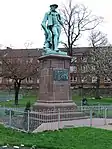 More images |
Robert Burns | Fountain Gardens, Paisley | 1895 | Statue on pedestal with plaques | Bronze and granite | Category B | Q17843407 | [16][17] | |
.jpg.webp) More images |
Statue of Admiral Robert Blake | Bridgwater, Somerset | 1900 | Statue on pedestal | Bronze and granite | Grade II* | Q30625603 | [18] | |
| William Ewart Gladstone | Central Lobby, Houses of Parliament, London | 1900 | Statue on pedestal | Marble | [5] | ||||
 More images |
Statue of Oliver Cromwell | Market Hill, St Ives, Cambridgeshire | 1901 | Statue on pedestal and steps | Bronze and Portland stone | Grade II | Q22917664 | [19][20] | |
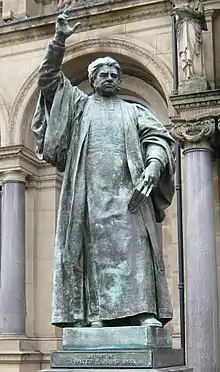 More images |
Dr. Walter Hook | City Square, Leeds | 1903 | Statue on pedestal | Bronze and granite | Grade II | Q26655854 | [21] | |
 More images |
Statue of Queen Victoria | Forecourt of Chester Castle, Cheshire | 1903 | Statue on pedestal | Bronze and stone | Grade II | Q15615686 | [22] | |
 |
Robert Ascroft M.P. | Alexandra Park, Oldham, Greater Manchester | 1903 | Statue on pedestal | Bronze and stone | Grade II | Q26497406 | [23] | |
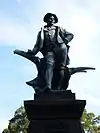 More images |
Robert Burns | The Domain, Sydney, Australia | 1905 | Statue on pedestal | Bronze and stone | [24] | |||
 More images |
Queen Victoria | Interior of Woolwich Town Hall, London | 1905 | Statue on pedestal | Marble | [25] |
1906-1909
| Image | Title / subject | Location and coordinates |
Date | Type | Material | Dimensions | Designation | Wikidata | Notes |
|---|---|---|---|---|---|---|---|---|---|
.jpg.webp) More images |
Justice | The Old Bailey, London | 1906 | Statue | Gilded bronze | Grade II* | Q55247277 | [12][26] | |
 More images |
James Nugent | St John's Gardens, Liverpool | 1906 | Statue on pedestal | Bronze and stone | Grade II | Q26504982 | [27] | |
 More images |
Marquess of Dufferin | Belfast City Hall | 1906 | 3 piece sculpture group on pedestal with canopy | Bronze and stone | [28][29][30][31] | |||
 |
Boer War memorial | The Great Hall, Guildhall, London | 1907 | 3 Relief panels | Bronze | [32][33] | |||
 More images |
Agriculture, Architecture, Pottery
and Engineering |
West side of Vauxhall Bridge, London | 1907 | Four statues | Bronze | Grade II* | Q1142134 | [5][13] | |
 More images |
Sir James Horner Haslett | Belfast City Hall | 1909 | Statue on pedestal | [31] | ||||
 More images |
Learning | World Museum, Byrom Street, Liverpool | 1909 | Statue on column | Bronze | Grade II* | Q5146857 | Former College of Technology and Museum extension, with other decoration by Pomeroy, architect E.W. Mountford.[34] | |
 More images |
Navigation | World Museum Liverpool | 1909 | Statue on column | Bronze | Grade II* | Q5146857 | [34] |
1910-1919
| Image | Title / subject | Location and coordinates |
Date | Type | Material | Dimensions | Designation | Wikidata | Notes |
|---|---|---|---|---|---|---|---|---|---|
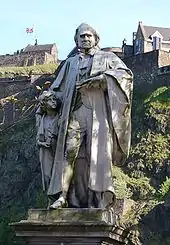 More images |
Thomas Guthrie | West Princes Street Gardens, Edinburgh | 1910 | Statue on pedestal | Portland stone | Category B | Q17813224 | [35] | |
.jpg.webp) More images |
Michael Bass, 1st Baron Burton | In front of Burton upon Trent Town Hall | 1911 | Statue on pedestal | Bronze and stone | Grade II | Q26290476 | [36] | |
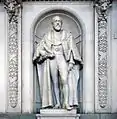 More images |
Earl of Derby | Interior of St George's Hall, Liverpool | 1911 | Statue | Marble | [37] | |||
| George Livesey | Grounds of former Livesey Museum for Children, London | Unveiled 1914 | Statue on pedestal | Bronze and stone | Grade II | Q26665510 | [38][39] | ||
 More images |
Robert James McMordie | Belfast City Hall | 1919 | Statue on pedestal | Marble | [31] |
1920-1924
| Image | Title / subject | Location and coordinates |
Date | Type | Material | Dimensions | Designation | Wikidata | Notes |
|---|---|---|---|---|---|---|---|---|---|
 More images |
Lord Curzon | Victoria Memorial, Kolkata | 1921 | Statue on pedestal | Marble | ||||
 More images |
War memorial | Ramsey, Cambridgeshire | 1921 | Statue on column | Stone | Grade II | Q26459919 | [40][41] | |
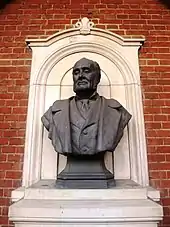 |
Sir Clements Markham | Courtyard of Lowther Lodge, London | 1921 | Bust | Bronze | Grade II* | [42][43] | ||
 More images |
War memorial | Coleraine, County Londonderry | 1922 | Statue on obelisk with base figure | Bronze and Portland stone | 5.4m high | [44] | ||
.jpg.webp) More images |
War memorial | Kensington High Street, London | 1922 | Cross on column and pedestal | Portland stone | 10.6m high | Grade II | Q26300012 | Architect: Hubert Christian Corlette.[45][46] |
 |
War memorial | Inver Park, Larne, County Antrim | 1922 | Cenotaph with sculpture figures | Portland stone and bronze | Grade B1 | [47] | ||
 More images |
Brigadier-General John Nicholson | Market Square, Lisburn | 1922 | Statue on pedestal | Bronze and stone | Category B | [48] |
Other works
Pomeroy's other architectural sculpture includes:
- City Hall, Cardiff
- Paisley Town Hall
- The pediment of Belfast City Hall[30]
- Holy Trinity Sloane Street, London
- Extensive work at Liverpool John Moores University
Smaller works include
- The Spearman bronze statue[49]
- Marble reredos at St Saviour's Church, Colgate, West Sussex[50]
- Statue of Sir Francis Bacon at Gray's Inn
Gallery
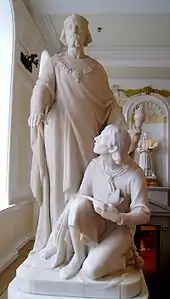 Sculpture of Hywel Dda, City Hall, Cardiff
Sculpture of Hywel Dda, City Hall, Cardiff The Lily of Killarney
The Lily of Killarney The Spearman bronze statue
The Spearman bronze statue_-_The_Wood_Nymph_(1908)_front_part_right%252C_Lady_Lever_Art_Gallery%252C_Port_Sunlight%252C_Cheshire%252C_June_2013_(9097771208).png.webp) The Wood Nymph (1908), Lady Lever Art Gallery, Port Sunlight, Cheshire
The Wood Nymph (1908), Lady Lever Art Gallery, Port Sunlight, Cheshire
References
- University of Glasgow History of Art / HATII (2011). "Frederick William Pomeroy RA". Mapping the Practice and Profession of Sculpture in Britain & Ireland 1851–1951. Retrieved 13 December 2020.
- "Frederick W. Pomeroy, R.A., 1856-1924". Victorian Web. Retrieved 9 October 2020.
- "Perseus". Victoria and Albert Museum. Retrieved 13 December 2020.
- "Frederick William Pomeroy RA (1856–1924)". Royal Academy. Retrieved 14 December 2020.
- Susan Beattie (1983). The New Sculpture. Paul Mellon Centre for Studies in British Art / Yale University Press. ISBN 0300033591.
- Historic England. "Church of Our Most Holy Redeemer, clergy house, campanile and parish hall (1209007)". National Heritage List for England. Retrieved 15 December 2020.
- "An athlete wrestling with a python". Art Gallery of New South Wales. Retrieved 14 December 2020.
- "Dionysus ?1890-1". Tate. Retrieved 15 December 2020.
- "Collections Online: Perseus". National Museum of Wales. Retrieved 16 December 2020.
- "The Art and Industry of Sheffield". The Victorian Web. Retrieved 15 December 2020.
- "Images of: "Virtues" by F.W. Pomeroy, 1888. Location Sheffield Town Hall". Public Art Research Archive, Sheffield Hallam University. 5 September 2006. Retrieved 15 December 2020.
- Jacqueline Banerjee (2009). "Justice - Frederick William Pomeroy". Victorian Web. Retrieved 6 November 2019.
- Historic England. "Vauxhall Bridge (1393011)". National Heritage List for England. Retrieved 16 December 2020.
- "A Noted English Sculptor. Mr. F. W. Pomeroy, R.A.". Obituaries. The Times. London. 27 May 1924. col E, p. 21.
- Historic Environment Scotland. "Glasgow Green, Doulton Fountain in front of People's Palace (Category A Listed Building) (LB33836)". Retrieved 16 December 2020.
- Historic Environment Scotland. "Fountain Gardens, Love Street: Burns Statue (Category B Listed Building) (LB39036)". Retrieved 13 December 2020.
- "Database of Public Memorials to Robert Burns Worldwide". Centre for Robert Burns Studies / University of Glasgow. Retrieved 15 December 2020.
- Historic England. "Blake statue (1205747)". National Heritage List for England. Retrieved 12 December 2020.
- Nikolaus Pevsner (1968). Bedfordshire and the County of Huntingdon and Peterborough. The Buildings of England. Harmondsworth: Penguin Books. p. 338. ISBN 0-14-0710-34-5.
- Historic England. "Statue of Oliver Cromwell (1161588)". National Heritage List for England. Retrieved 13 December 2020.
- Historic England. "Statue of Dean Hook (1375032)". National Heritage List for England. Retrieved 13 December 2020.
- Historic England. "Statue of Queen Victoria opposite portico of Assize Courts (1245519)". National Heritage List for England. Retrieved 13 December 2020.
- Historic England. "Statue of Robert Ascroft MP (1201703)". National Heritage List for England. Retrieved 14 December 2020.
- "Robert Burns". Monument Australia. Retrieved 13 December 2020.
- "The entrance hall at Woolwich Town Hall with the Queen Victoria statue in the foreground". Historic England. Retrieved 13 December 2020.
- Historic England. "Central Criminal Court (1359218)". National Heritage List for England. Retrieved 12 December 2020.
- Historic England. "Nugent Monument (1209934)". National Heritage List for England. Retrieved 12 December 2020.
- "Lord Dufferin Memorial, Belfast". The Victorian Web. Retrieved 12 December 2020.
- "The Lord Dufferin Memorial, Belfast by Frederick William". The Victorian Web. Retrieved 12 December 2020.
- "Belfast City Hall". Causeway Coastal Path. Retrieved 13 December 2020.
- "City Hall Memorials and statues". Belfast City Council. Retrieved 13 December 2020.
- "War memorials". City of London. 5 November 2020. Retrieved 13 December 2020.
- "War Memorials Register: Royal Fusiliers". Imperial War Museum. Retrieved 13 December 2020.
- Historic England. "College of Technology and Museum Extension (1205724)". National Heritage List for England. Retrieved 12 December 2020.
- Historic Environment Scotland. "West Princes Street Gardens, Thomas Guthrie Monument (Category B Listed Building) (LB27858)". Retrieved 13 December 2020.
- Historic England. "Statue of Michael Arthur Bass (Grade II) (1038704)". National Heritage List for England. Retrieved 9 July 2020.
- Sharples, Joseph; Pollard, Richard. Liverpool F.C.. In Pollard, Richard; Pevsner, Nikolaus (2006). Lancashire: Liverpool and the South-West. The Buildings of England. New Haven and London: Yale University Press. p. 296. ISBN 0-300-10910-5.
- Historic England. "Statue of George Livesey situated in the garden to the rear of the former Camberwell Library and Livesey Museum (1385743)". National Heritage List for England. Retrieved 14 December 2020.
- "Statue of "Peckham hero" should go on show". The Peckham Peculiar. 14 April 2016. Retrieved 15 December 2020.
- "War Memorials Register: Ramsey". Imperial War Museum. Retrieved 13 December 2020.
- Historic England. "War memorial (1166434)". National Heritage List for England. Retrieved 13 December 2020.
- Historic England. "Royal Geographical Society (1217774)". National Heritage List for England. Retrieved 17 December 2020.
- "Royal Academy Illustrated 1920". Royal Academy. Retrieved 17 December 2020.
- "War Memorials Register: Coleraine". Imperial War Museum. Retrieved 12 December 2020.
- "War Memorials Register: Kensington Battalions". Imperial War Museum. Retrieved 12 December 2020.
- Historic England. "War memorial at corner with Kensington Church Street (1222889)". National Heritage List for England. Retrieved 12 December 2020.
- "War Memorials Register: Larne". Imperial War Museum. Retrieved 12 December 2020.
- "John Nicholson (1821–1857) Soldier and Colonial Governor". Dictionary of Ulster Biography. Retrieved 15 December 2020.
- Encyclopædia Britannica, ed. 1911, vol. 24, pg. 505, Plate IV.
- D Robert Elleray (2004). Sussex Places of Worship. Worthing: Optimus Books. p. 17. ISBN 0-9533132-7-1.
- John Braid (27 September 2020). "Literary Locations #76:Southwell". Nottingham UNESCO City of Literature. Retrieved 14 December 2020.
External links
| Wikimedia Commons has media related to Frederick William Pomeroy. |
- 22 paintings by or after F. W. Pomeroy at the Art UK site